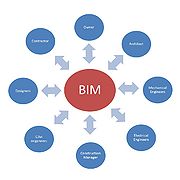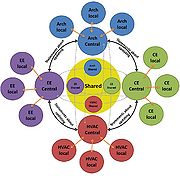Advantages of BIM for time management of building projects
(→Time management with BIM) |
|||
| Line 60: | Line 60: | ||
===Time management with BIM in building phase === | ===Time management with BIM in building phase === | ||
| + | [[File:BIM Figure4D.jpg|thumb|right|]] | ||
===Time managament with BIM in operation time === | ===Time managament with BIM in operation time === | ||
| − | |||
==References== | ==References== | ||
<references/> | <references/> | ||
Revision as of 19:04, 17 September 2016
Building Information Modeling (BIM) is an information management method or a digital representation of physical and functional characteristics of a facility. BIM is a shared knowledge resource for information about a facility forming a reliable basis for decisions during its life-cycle; defined as existing from earliest conception to demolition. Building information models are set of information in files which may be collected, supplemented and edited in all the building period of existence.
BIM like a tool is a very big influence to building industry. This tool helps building companies, individual users and government agencies easy make some processes. One of the key benefits is a fast time management. Fast communication process and communication diversity, which means that project manager will need a good knowledge about time management.
BIM helps not only time management but also to complete the cost of project effectively and to identify risks, to plan quantity of employees, dealing with communication problems and to provides a visual effect to the customer.
Contents |
About BIM
Building Information Modeling (BIM) is an information management method or a digital representation of physical and functional characteristics of a facility. BIM is a shared knowledge resource for information about a facility forming a reliable basis for decisions during its life-cycle; defined as existing from earliest conception to demolition.
4D BIM, an acronym for 4D Building Information Modeling and a term widely used in the CAD industry, refers to the intelligent linking of individual 3D CAD components or assemblies with time- or schedule-related information.
5D BIM, an acronym for 5D Building Information Modeling, is a term used in the CAD and construction industries, and refers to the intelligent linking of individual 3D CAD components or assemblies with schedule (time - 4D BIM) constraints and then with cost-related information
6D BIM, an acronym for 6D Building Information Modeling and a term widely used in the Construction industry, refers to the intelligent linking of individual 3D CAD components or assemblies with all aspects of project life-cycle management information.
BIM origins
Although it is considered that the term BIM, as well as its main ideas have been created by software developers such as Autodesk or Graphisoft. Technologies and processes that are driven by BIM have begun developing for more than 40 years ago, when in 1974 Charles Eastman published "An Outline of the Building Description System.” [1] This article included the idea of parametric design, 2D drawing creation of the model, as well as the amount of output. It was the first software that was described in the individual library elements that could be added to the model. Consequently, the idea of BIM is presented 7 years before the foundation of Autodesk (1982) and nine years before the Graphisoft (1984) [2]
In 1982 in Budapest, Hungary physicist Gabor Bojar began the development of the program, based on the principle of BDS technology. In 1984 there was presented CH Radar program for the Apple Lisa operating system, which was later renamed to ArchiCAD. Consequently, it is the first ArchiCAD BIM software, designed for personal computers.
In 2000, Iowin Jungreis and Leonid Raiz enterprise “Charles River” in Cambridge Software presented a program called Revit, which, thanks to the object-oriented programming, made modeling much easier and more efficient. In 2002, Autodesk purchased the company and launched Revit development. Revit made a revolution in the design in BIM, creating a platform where visual programming environment can create groups of parametric elements, including time as a fourth dimension of the components. It allows to create time schedules, specifications and simulation based on the BIM model.
BIM software
There are two kinds of BIM software: authoring software and coordination software. As the technology matures single software packages may be used that contain both elements. Common authoring software platforms include: Autodesk Revit Architecture; Bentley Systems; Coordination Software; Autodesk Navisworks, and Bentley Projectwise. BIM coordination software is potentially revolutionary for construction management and contractors in particular. This software takes the model made by the authoring software and attaches cost, scheduling and other information to it thus creating a tool for achieving improved project delivery.
Time management with BIM
Time Management
Time management is the process of organizing and planning how to divide your time between specific activities, especially to increase effectiveness, efficiency or productivity. It is a meta-activity with the goal to maximize the overall benefit of a set of other activities within the boundary condition of a limited amount of time. Good time management enables you to work smarter – not harder – so that you get more done in less time, even when time is tight and pressures are high. [3] Time management is usually a necessity in any project development as it determines the project completion time and scope.
Six essential elements of time management: [4]
- Managing Goals: Goals are important in a person's life. Without goals, one will wander aimlessly through life, haunted by the feeling of not accomplishing anything. Personal goals will steer an individual in the right direction and will help this person to focus his strengths in achieving that goal.
- Managing Tasks: Every person tackles important tasks every day. Managing these tasks is imperative to make sure that an individual do not end up with too many things to do. In addition, managing tasks will ensure that a person did not forget any important errands or miss any deadlines.
- Prioritize: Learning to prioritize is also a good skill to complement managing tasks. Since time is very limited, it is vital that a person completes his priorities first before anything else. That way, a person gets closer to accomplishing his goals every single day. Prioritizing is simply knowing what is necessary to finish a goal and knowing what to do next.
- Utilizing the Calendar: A calendar is important to manage one's time fully. Whether it be a desk calendar or an electronic one, it is critical that a person have one. It is also recommended, if you have multiple calendars, that all calendars be synchronized so as not to miss anything.
- Procrastination Management: Everyone has a tendency to procrastinate and, for some, it is a feeling that is very difficult to resist. However, for one to be a successful time manager, one must learn to resist the calls of procrastination.
- Reminder Systems: A good follow-up system is necessary so old tasks or projects are not forgotten. There are new things to do each day that might need much attention and a good reminder system will definitely help manage all of these tasks.
In recent years, all over the world there have been made different time planning events for people to get more time and for processes to take place rapidly. The construction industry is no exception, but it is famous for the project not being completed in time. Customers and members of the construction industry have shown very big willingness to work and build buildings faster. With BIM capabilities it is better to do so; in recent years BIM has been developing very fast. Time is very important to the customer, because the costumer has a strong interest in completing the construction or buildings faster so that it can begin to operate. BIM allows to quickly start their operations and gain revenue.
Time management with BIM in design phase
Time management with BIM in building phase
Time managament with BIM in operation time
References
- ↑ An Outline of the Building Description System> Eastman, Charles; Fisher, David; Lafue, Gilles; Lividini, Joseph; Stoker, Douglas; Yessios, Christos (September 1974). An Outline of the Building Description System. Institute of Physical Planning, Carnegie-Mellon University. http://eric.ed.gov/?id=ED113833
- ↑ About Graphisoft, Graphisoft, http://www.graphisoft.com/info/about_graphisoft/
- ↑ What Is Time Management? Working Smarter to Enhance Productivity https://www.mindtools.com/pages/article/newHTE_00.htm
- ↑ Jussila Harri "Time Management Definition – The 6 Essentia" in Asministrative assistant resource. http://www.administrativeassistantresource.com/articles/view.php?article_id=4896



